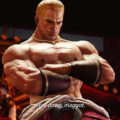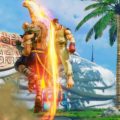Special Feature: Darkstalkers’ 25th Anniversary

Today marks 25 years since the original Darkstalkers released in Japanese arcades, where it was known as “Vampire.” It was the first significant post-Street Fighter fighting game experiment from Capcom. While the company’s flagship fighter adhered to more traditional martial arts anime-style conventions, Darkstalkers offered the development team the opportunity to get crazier and zanier. The game contained a colorful and animated cast whose designs stick out to this day, and its faster-paced fighting system allowed for different types of combos and quick battles. It was very different from any title in the genre on the market at the time, which turned out to be a blessing and a curse given its popularity.
Darkstalkers was another in a line of Capcom projects originally planned to be based on licensed properties, with this one intended to be a fighter starring Universal monsters like Dracula, Frankenstein, and The Wolf Man. The plan didn’t get very far when the license couldn’t be obtained, so they made a fighting game with characters and creatures inspired by those from horror movies and fables. The result was likely a better alternative, given how creative the team could get in lieu of the need to stick to Universal’s established conventions — even if Universal would have been flexible with the potential usage of their monsters.

The first game started with ten playable characters, an average amount for a game released in 1994. But this was fine thanks to how unique every character felt, not to mention how a lower amount of characters can make it easier learn match-ups and adjust to the gameplay. Darkstalkers introduced features adopted in subsequent (and, to this series’ chagrin, more popular) fighting games from Capcom, which included air blocking, chain combos executed by pressing one button after another to string normal attacks together, and EX techniques that used a small portion of the super meter for enhanced special attacks. Note that the super meter itself and the concept of super attacks debuted in Super Street Fighter II Turbo mere months before this game released.
The gameplay features included highlight just how important the Darkstalkers series was for not only Capcom’s fighting game history, but the genre as a whole. Chain combos and air blocking made their way into Street Fighter Alpha (though only two characters kept chain combos after the first game), while EX techniques were used in Street Fighter III. The chain combo feature was expanded upon for Capcom’s Marvel games, which also included air combos. Several fighters from other publishers were inspired by Capcom’s titles, and the features listed above became common for the genre.
The cast expanded as more installments were made, and culminated with 18. It shows how good a job the developers did in making them appealing that no character involved was ever disliked. Some faces were, of course, more popular than others, like Morrigan, Felicia, and Demitri, with characters like Lilith and B.B. Hood to a lesser extent.

The developers put significant effort into making the animations look good for the game’s cartoonishly violent aesthetic — a good contrast to gruesome fighters like the Mortal Kombat games and others at the time. The team did a lot with the lower budget and resources given to them compared to what Capcom allocated to Street Fighter games, and some animations in particular were so good that some sprites were used for years — especially Morrigan’s, which became a meme.
Despite receiving several installments, along with an anime OVA series and a hilariously-bad cartoon adaptation, the Darkstalkers series was never as popular as it could have been. The cartoonish horror themes of the main games weren’t quite as appealing as the more grounded Street Fighter style for the mainstream audience, but Capcom not taking it that seriously outside Japan didn’t help. Several arcades in the US didn’t carry any of the games they brought over, and the confusing home releases didn’t help. The first game released on PSOne, but the sequel was exclusive to Sega Saturn. The third game, however, only released on PSOne. Weird.
The arcade releases weren’t great either thanks to how difficult they were to follow, especially in Japan. The first Darkstalkers/Vampire received a sequel with Night Warriors: Darkstalkers’ Revenge (Vampire Hunter in Japan), and another successor with Darkstalkers 3 (Vampire Savior in Japan). For some strange reason, Capcom felt the need to release two updated versions with Vampire Hunter 2, an enhanced version of the second game, and Vampire Savior 2, an enhanced version of the third game, within months of each other. This understandably confused Japanese players to the point that several of them didn’t bother with the games, and Capcom skipped releasing both of them in arcades outside the country. This stunt ended up killing the franchise.

It’s a real shame Darkstalkers went out that way, which is partly why there have been several attempts in the last decade by Street Fighter producer Yoshinori Ono to revive it. He started the “Darkstalkers Are Not Dead” campaign, which went as far as having a audience wave money in the air to convince Capcom that a consumer base existed for it. It even received a teaser trailer at New York Comic-Con in 2012, done in the same watercolor style as many Street Fighter IV and V cinematic trailers. Capcom used the Darkstalkers Resurrection collection to gauge interest, rereleases of Night Warriors and Darkstalkers 3 with online play and visual enhancements. It unfortunately (and ironically, given the name) underperformed, and took the new project down with it.
This was not sound logic. New projects always sell more than rereleases, with the only near-exceptions being in very popular franchises. It’s almost like Capcom’s higher-ups never wanted to fund a new game, and looked for any excuse to pull out. Given this, and how they’ve been treating SFV recently (it’s received no support outside new outfits since Kage released in December 2018), there’s little chance of a new game coming.
It’s been over two decades since the last new installment, but the Darkstalkers games we did receive are still fondly remembered by the fighting game community, and certain games are still played in some circles. We’ll always have the old games from the halcyon days, especially when Capcom actually rereleases them on modern platforms. At least the characters and their outfits will live on.





